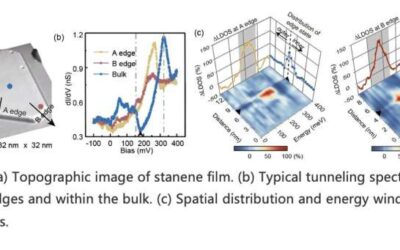Stanene is a topological insulator comprised of atoms typically arranged in a similar pattern to those inside graphene. Stanene films have been found to be promising for the realization of numerous intriguing physics phases, including the quantum spin Hall phase and...
Quantum Physics
A model that can predict the exact quasi-particle properties of heavy Fermi polarons
Physicists studying quantum many-body physics very rarely reach exact solutions or conclusions, particularly in more than one dimension. This is also true for the Fermi polaron problem, describing instances in which the many-body quantum background is a...
Using laser technology to measure the rotational cooling of molecular ions colliding with electrons
When it is free in cold space, a molecule will spontaneously cool down by slowing its rotation and losing rotational energy in quantum transitions. Physicists have shown that this rotational cooling process can be accelerated, slowed down and even inverted by the...
Thermalization and information scrambling in a superconducting quantum processor
In recent years, physicists have carried out extensive studies focusing on quantum technology and quantum many-body systems. Two out-of-equilibrium dynamical processes that have attracted particular attention in this field are quantum thermalization and information...
Searching for cosmic-ray boosted sub-GeV dark matter using data from the PandaX-II experiment
Physicists worldwide are continuing their search for dark matter, an elusive type of matter that does not absorb, reflect or emit light and is believed to make up most of the matter in the universe. A type of dark matter that many teams have been specifically looking...
Using renormalization group methods to study how the brain processes information
Past neuroscience research suggests that biological neural networks in the brain could self-organize into a critical state. In physics, a critical state is essentially a point that marks the transition between ordered and disordered phases of matter.
A thermal superconducting quantum interference proximity transistor
Superconductors are materials that can achieve a state known as superconductivity, in which matter has no electrical resistance and does not allow the penetration of magnetic fields. At low temperatures, these materials are known to be highly effective thermal...
Study introduces loss-free matter-wave polaritons in an optical lattice system
Polaritons are quasiparticles that are formed when photons couple strongly with excitations of matter. These quasi-particles, which are half-light and half-matter, underpin the functioning of a wide range of emergent photonic quantum systems, including...
Study achieves the optical coherent manipulation of circular Rydberg states
Rydberg atoms are excited atoms that contain one or more electrons with a high principal quantum number. Due to their large size, long-range dipole-dipole interactions and strong coupling to external fields, these atoms have proved to be promising systems for the...
Study highlights the possibility of building wave-shape-tolerant qubit gates
Quantum computers, machines that leverage quantum states to perform computations and store data, could soon revolutionize the computing industry, achieving significantly greater speeds and performance than existing computers. While countless companies worldwide,...










